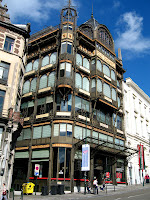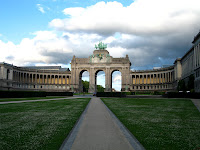After visiting the Brussels Cathedral, we headed to the
train station to catch a train to Bruges.
We bought our tickets, which do not list a platform number or a
time. Since there are so many trains to
Bruges each day, it doesn’t matter. Of
course, it makes finding the train a little more difficult. First, S asked the information desk and he
told us a platform. However, the sign on
that platform did not list Bruges as a destination. Since we would rather be safe than sorry, we
abandoned that train and I went to the info desk (so it wouldn’t be the same
person) and asked. He said “platform 9
at 9:56.” Well, it was 9:55, but we
ended up having plenty of time. And so,
we were off.

 After that we walked over to the old fish market which is
now used by artists to sell their paintings.
I bought a small watercolor of Bruges before we started walking down the
canal. We even saw the famous dog that
always sits in a window over the canal. I
googled him and apparently his name is Fidel.
After that we walked over to the old fish market which is
now used by artists to sell their paintings.
I bought a small watercolor of Bruges before we started walking down the
canal. We even saw the famous dog that
always sits in a window over the canal. I
googled him and apparently his name is Fidel.
 Lastly, we walked over to see the traitor’s gate. In the 15th century, Bruges was
walled in and the gates closed every night so armies couldn’t attack. However, one night, François vander Straeten
opened the gate to the French from the inside.
He was later executed as a traitor and his skull was displayed on the
gate as a reminder of what would happen to anyone else who tried the same
thing. Francois’s actual skull is
long gone, but there is a bronze copy there so the message remains.
Lastly, we walked over to see the traitor’s gate. In the 15th century, Bruges was
walled in and the gates closed every night so armies couldn’t attack. However, one night, François vander Straeten
opened the gate to the French from the inside.
He was later executed as a traitor and his skull was displayed on the
gate as a reminder of what would happen to anyone else who tried the same
thing. Francois’s actual skull is
long gone, but there is a bronze copy there so the message remains.
Belgium is a pretty, if a little flat and boring, country,
so I mostly read my book. Once in
Bruges, we walked toward the city center, using the tall towers of churches and
the famous belfry as our guides. The
medieval streets are narrow and the houses are very colorful. I really enjoyed walking around. Oddly, we managed to not see a single canal
for probably the first 3 or so hours that we were there.
We saw the Church of Our Lady (finished in the 15 century)
with its 401 ft. tower, which still stands as the second tallest brick tower in
the world. We also popped into St.
Salvator's Cathedral for a few minutes and heard a performance of Queen of the Night from Mozart’s The Magic Flute. We eventually ended up at the belfry.
We then got in line to climb it. Only 70 people can go up the tower at a time
because, well, it’s old (rebuilt in 1280) and it apparently leans 1 m to the
east. Also, you walk up 366 steps (272
feet), all in a small circular staircase, so no more than 70 people would
really be practical. You first come to a room that was used to
store important documents. You can still
see the iron chests sitting behind iron gates that had 10 different locks that
had keys kept by 10 different people (now that’s security). Then you keep going up and you pass the
“Great Bell.” It is the biggest bell I
have ever seen. It weighs 11,000 pounds
and it isn’t really rung that often.
Above the great bell, you see the carilloner’s room. The belfry was turned into an instrument in
the 16 century and Bruges has employed a carilloner since
1604. Originally it had 35 bells, but
this has since increased to 47. (side
note: I doubt the Bruges carilloner
plays such hits as Thriller or Bad Romance, which makes me glad I
went to Iowa State. Free bell concert
everyday at noon where you never know what you’ll hear)
Next you reach the room that basically turns the belfry into
a giant music box. It has a large brass cylinder
(apparently the largest in the world) with little tabs that the bells are
connected to (similar to the metal bumps that pluck a music box). Every 2 years, the tabs are moved and the
songs that play every quarter hour are changed.

Then, you finally make it to the top. You can look out over Bruges see the bells,
ect. Then you have to fight your way
back down, which is difficult, with so many people also trying to come up. Let’s just say, it feels like more than 70,
even though it isn’t.
Next we walked through Burg Square, where city hall and the Basilica
of the Holy Blood are located. We were
on our way to the chocolate museum!! The
chocolate museum, or Choco Story, is great.
They make chocolate there, so the building smells awesome and the
history of chocolate from the Mayans onward is presented. It tells how it started as a drink and
currency for Mayans and then was brought to Europe where it gained popularity
with the upper class. Eventually,
someone started adding sugar to it (thank goodness!) and it really became
popular. The chocolate pot with a
“frother” stick was invented and they drank it out of giant mugs (people after
my own heart). Eventually, solid
chocolates came to pass and Belgium really started to excel. They even sell chocolate tins with the royal
family on the lid.
After the tour, we saw a chocolatier give a demo on how they
make filled chocolates. Then, we got
samples!! Best museum ever. J
 After that we walked over to the old fish market which is
now used by artists to sell their paintings.
I bought a small watercolor of Bruges before we started walking down the
canal. We even saw the famous dog that
always sits in a window over the canal. I
googled him and apparently his name is Fidel.
After that we walked over to the old fish market which is
now used by artists to sell their paintings.
I bought a small watercolor of Bruges before we started walking down the
canal. We even saw the famous dog that
always sits in a window over the canal. I
googled him and apparently his name is Fidel.
Anyway, we wound our way through the streets to the
windmills on the far side. There are 4
windmills still standing. They were
originally from the 1780’s. Some are
original but at least one has been reconstructed. As will most windmills, they were used to
mill grain. Now, you can tour some of
them, but we just walked by and enjoyed the view.
We also tried to visit a garden that was mentioned on our
map. It said to go inside a door, ring
the buzzer, and wait for a nun to let you in.
We were let in, but no nun came to guide us. We saw a courtyard, but we’re not sure it was
the correct one. Needless to say, we
felt awkward and left.
We then ended up in the main square by the belfry again and
got some French fries from a restaurant that will apparently fry whatever your
heart desires. We then decided to find
the cannon that is stuck in a sidewalk that no one really knows the story
behind. It also said we probably
wouldn’t notice it. We followed a police
marching band (that was playing the Marine corp hymn) in the appropriate
direction, and didn’t see it. We rechecked
the map, retraced our steps about 20 feet and there it was: nose down in the sidewalk, clear as day, and
yet completely miss-able.
 Lastly, we walked over to see the traitor’s gate. In the 15th century, Bruges was
walled in and the gates closed every night so armies couldn’t attack. However, one night, François vander Straeten
opened the gate to the French from the inside.
He was later executed as a traitor and his skull was displayed on the
gate as a reminder of what would happen to anyone else who tried the same
thing. Francois’s actual skull is
long gone, but there is a bronze copy there so the message remains.
Lastly, we walked over to see the traitor’s gate. In the 15th century, Bruges was
walled in and the gates closed every night so armies couldn’t attack. However, one night, François vander Straeten
opened the gate to the French from the inside.
He was later executed as a traitor and his skull was displayed on the
gate as a reminder of what would happen to anyone else who tried the same
thing. Francois’s actual skull is
long gone, but there is a bronze copy there so the message remains.
We then headed back to the train station and went back to
Brussels for the night. The next day, bright and early, we were off to the
airport to fly to Norway!























